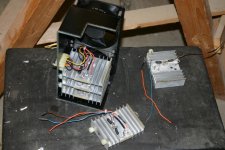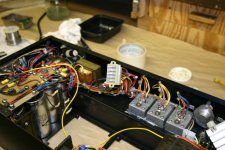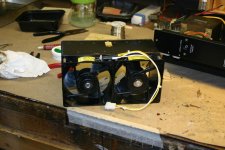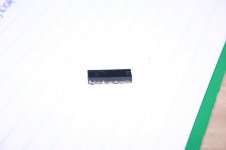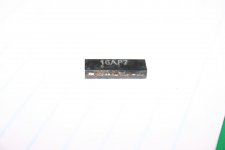Marty asked for comment on how I repair some of this stuff;
Cleaning the circuit boards is rather easy, I use isopropyl alcohol that I purchased from Walgreens. It's good because it will cut the oil and dirt and will evaporate. I have a variety of brushes, old artist brushes, tooth brushes and paint brushes. And paper towels. Nothing fancy. The front panel control board had some corrosion on it. It appears as green oxide. Copper and brass oxide is green. Here I used vinegar, which is a mild acid. Brush it on let it sit for a few minutes and wash it off with the alcohol. Depending on the amount of corrosion, you may have to do this a few times. You have to be careful and not let these liquids (especially the vinegar) get into parts like potentiometers. It could cause more trouble.
Once the board has been cleaned off, inspect the traces with a magnifying glass. Look closely at the corroded areas. Look for cracks and opens in the traces. Verify an open with an ohm meter. If you find an open, clean the trace and re-tin with solder. Then prepare a short piece of thin copper wire to fit over the open. Tin the wire and then lay it in place. hold it down with a pick and heat it with a solder iron until it is soldered in. Then recheck the trace for continuity. Again pretty simple.
My board had corrosion over 1/8 of the board and affected some of the parts. Some resistor and other part leads were broken off. These parts have to be removed. I use a de soldering braid to wick the solder away from the joint. First apply a little flux to the joint, then heat the joint and apply a little new solder to it. Then I flux the de soldering braid. Hold the braid on the solder joint and heat it with the iron. The braid will wick up some solder. When the braid is saturated, stop and cut that piece of braid off. Once most of the solder is off, try once more. This time place the braid one the part lead and CB hole, the push the iron into the braid so it contacts the lead and try's to enter the hole. This will wick most of the solder out of the hole. You can gently break (assuming the part is junk) the part and then pull on its leads and it will come out.
My front panel had two switches that were froze. The metal sides of the switches rusted, and this rust expanded into the switch and caused the switch slider to
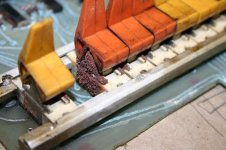
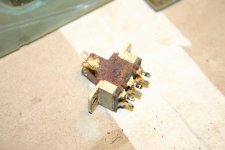
bind in place. First remove the switch with the method above. You can remove the switch lever by prying the metal sides apart, but it is not necessary, your choice. Then on each side of the switch the metal pieces have two expander that hold the bottom fiber contact plate. Gently compress each of these, then with a thin tool (razor blade), gently pry the finer bottom off. Once the bottom has been removed the slider and it's contacts can be removed. The contacts are loose so don't lose them. Now the switch is apart. I first soaked every thing except the fiber base and contacts in some soapy water with ammonia, scrubbed them and let them dry. The base contacts are cleaned with a brass brush and alcohol. I had to use a pick to get some of the crusty stuff off. The slider contacts and the metal sides of the switch are then soaked in vinegar to remove the corrosion. The contacts only for a few minutes. They then can be removed and buffed up. The sides of my switch were pretty badly corroded. I let them in the vinegar for a day or so. I would brush them and pick at the rust. You have to be careful here, if the switch is too rusty you may not be able to save it. Once you are satisfied with the cleanliness of the parts, re assemble them. Place the slider into the switch case
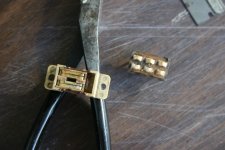
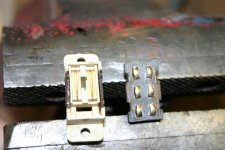
and the contacts in the slider. I used a little floor wax on the sides of the slider to aid in movement, but not too much. You don't want the wax to eventually get unto the contacts. Next place the fiber base back onto the switch case. If you try and bend the tabs back in place to hold the base onto the switch, they most likely will break off. So I just held the switch together with string and used a little JB weld to secure the base. Put the lever back on by bending the sides. Test your switch and then re-solder it back on to the CB.

Hope this helps. Mike








